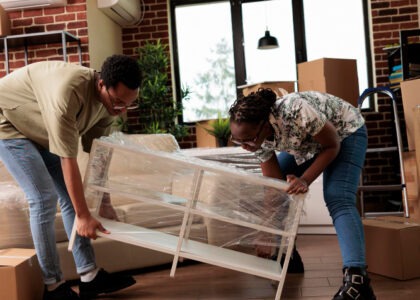How to Prepare for Movers: A Checklist. Moving homes or offices can be an overwhelming process, with a myriad of tasks that need careful planning and execution. Partnering with a professional moving company like Stride Movers can significantly ease this process.
From categorizing and packing all your belongings to orchestrating tasks with a professional moving service, each stage can greatly influence the outcome of your moving day. A well-prepared move reduces stress and ensures that your belongings reach your new location safely and in a timely manner.
The purpose of this checklist is to guide you through the preparation process for movers. It helps you to stay organized, ensures that you do not overlook any critical aspects of your move, and makes the moving process smooth and hassle-free. With this comprehensive list, you will have a step-by-step guide to follow, ensuring that you are fully prepared when the movers arrive.
Understand Your Moving Needs
Before diving into the moving process, it’s essential to understand your specific moving needs. This understanding forms the basis of your moving plan and enables you to communicate your requirements clearly to your chosen moving company.
- Type of Move: Start by determining the nature of your move. Is it local, long-distance, or international? The type of move will impact the services you require and the moving company you choose.
- Special Items: Identify if you have any special items that need extra care during the move. These could be antiques, pianos, artwork, or other valuables. Special items often require additional packaging or a specific mode of transport.
- Volume of Belongings: Estimate the volume of items you plan to move. This will help you get a more accurate quote from your moving company and assist in planning the logistics of your move.
- Additional Services: Decide if you require any additional services, such as packing, unpacking, or storage. Some moving companies, like Stride Movers, offer these as part of their comprehensive service package.
- Moving Dates: Finalize your moving dates. Having a clear timeline can help you better coordinate with your moving company and plan your tasks accordingly.
- Budget: Establish a budget for your move. This will guide your choice of moving services and help you avoid unnecessary expenses.
- Insurance: Consider if you need to purchase additional insurance for your move, especially if you have valuable items. Most moving companies provide basic coverage, but it may not be sufficient for high-value items.
Read More: Best Moving Companies in Deerfield Beach
Research and Hire a Professional Moving Company
Discovering dependable moving companies is a crucial aspect of your relocation process when the moving truck arrives at your own personal driveway. Start by gathering recommendations from friends or family who have recently moved, or search online for top-rated moving companies in your area.
A reputable moving company like Stride Movers will have a solid track record of providing reliable and efficient services. Ensure you check the potential movers’ reviews, licenses, and insurance. Online reviews can give you a sense of the company’s reputation and how they handle customer complaints.
Additionally, check that they have adequate insurance coverage to protect your belongings in the event of loss or damage during the move. Finally, get moving estimates from at least three different movers and take the time to understand the contract, including costs, payment terms, and their policy for damaged or lost items, to avoid any unexpected surprises during your move.
Inventory and Declutter
Decluttering gives you a fresh start in your new home, free from unnecessary clutter. Here are seven tips for successful inventory and decluttering:
- Room by Room: Tackle one room at a time to make the process more manageable.
- Categorize Your Items: As you inventory, categorize your items into ‘keep,’ ‘donate,’ ‘sell,’ or ‘throw away.’
- Sell or Donate: Plan a garage sale or donate items you no longer need. Remember, one person’s trash could be another’s treasure.
- Use Apps: Consider using inventory apps or simply a spreadsheet to keep track of your items. Include a brief description and a photo of each item.
- Value Estimation: If you’re moving valuable items, you might want to note their approximate value for potential future insurance claims.
- Keep Your Inventory Safe: Store your inventory list safely—consider saving it in cloud storage to ensure it doesn’t get lost in the move.
Proper Packing Procedures
Packing correctly is vital when moving, as it ensures the safety and protection of your belongings during transit. Using suitable packing materials and applying the right packing techniques can substantially minimize the risk of damage.
1. Invest in Quality Packing Supplies
One of the best ways to ensure the safety of your items during a move is by investing in high-quality packing materials. This includes sturdy, double-walled boxes that can withstand the pressures of moving, bubble wrap for cushioning, packing paper to prevent scratches, strong packing tape to secure boxes, and permanent markers for labelling.
Specific moving boxes, like wardrobe boxes for clothes and dish pack boxes for kitchenware, are particularly helpful for packing delicate or bulky items.
2. Use the Right Packing Techniques
Various items necessitate distinct packing strategies. For instance, breakable items such as glassware or ceramics should be wrapped individually in bubble wrap or packing paper, providing an extra layer of protection. To prevent items from shifting during transit, fill any remaining empty space in the box with crumpled paper, bubble wrap, or packing peanuts.
3. Pack Room by Room
To make the packing process more organized and less overwhelming, tackle it room by room. This systematic approach makes packing more manageable and facilitates a smoother unpacking process at your new home, as items from the same room will be grouped together.
4. Label Your Boxes
Proper labeling is a small step that saves significant time during unpacking. Mark each box with its content and the room it belongs to, which will guide the movers in your new home. For boxes containing fragile items, marking the box as ‘Fragile’ on all sides is crucial, alerting anyone handling the box to do so with extra care.
5. Create a Box Inventory
In addition to itemizing your belongings, creating a box inventory is an excellent way to keep track of what items are in each box. This can be extremely helpful if you need to find a specific item before you’ve had a chance to unpack everything.
6. Do Not Overpack Boxes
While it may seem efficient to pack a box to its brim, overpacked boxes are prone to breaking under excessive weight and can also be hazardous to lift. Distributing heavier items across multiple boxes is recommended, aiming for a manageable weight in each box.
7. Specialty Items Need Special Attention
Items of significant value, sentiment, or uniquely shaped items, such as artwork, electronics, or musical instruments, may require special packing procedures or custom crates.
Researching these procedures or consulting with professional movers like Stride Movers if you’re unsure about the best practices for packing these items is important. They have the knowledge and experience to safely ensure these items reach your new home.
Read More: Packing and Unpacking Services in Deerfield Beach
Prepare Large Appliances and Furniture
Preparing large appliances and furniture for a move is a crucial step that should not be overlooked. This process ensures that these items are ready for safe transportation, protecting them from damage and making them easier to handle.
Moreover, dismantling furniture can also maximize space in the moving truck, thus reducing the overall cost of moving. Here are seven short tips on preparing large appliances and furniture for moving:
- Refer to Manuals: Most large appliances and furniture pieces come with manufacturer instructions on disassembling and preparing them for moving. Always check these manuals first.
- Disconnect and Clean Appliances: Disconnect appliances from their power source, and clean them thoroughly. This includes defrosting the refrigerator and draining washing machines or dishwashers.
- Secure Loose Parts: For appliances with removable parts, ensure that these parts are secured or packed separately to prevent loss or damage.
- Disassemble Furniture: Break down furniture into smaller parts if possible. Remove table legs, take apart modular furniture, and remove cushions from couches.
- Use Protective Covers: Wrap large appliances and furniture pieces in moving blankets or protective covers to prevent scratches or other damages.
- Tape Doors and Drawers Closed: Tape doors and drawers shut to prevent them from swinging open during the move. However, be careful not to place the tape directly on the painted or finished surfaces.
- Hire Professionals If Needed: If the process appears too overwhelming or you possess specialty furniture necessitating gentle handling, consider the need to hire movers like Stride Movers, who have experience handling large appliances and furniture.
Essentials Box Preparation
The concept of an “essentials box” is a vital aspect of moving that can make your first few days in a new home more manageable. This box (or boxes) should contain items you’ll need immediately upon arrival at your new place, even before you begin unpacking everything else.
The goal is to ensure that the transition process is as smooth as possible, providing you with quick access to necessary items. So, what should go in your essentials box? It varies from person to person, but some common items include toiletries, medications, a change of clothes, bedding, towels, phone chargers, important documents, snacks, and a few kitchen items like a kettle, mugs, and utensils.
Including toilet paper, a toolkit, and cleaning supplies can also be beneficial. This box should be the last one packed into your moving vehicle, ensuring it’s the first one you unpack. Doing so ensures immediate access to items of immediate necessity, which can significantly decrease the stress associated with moving.
Preparing Yourself and Your Family for the Move
Here’s how to ensure that everyone in the family, including your pets, is well-prepared for the move:
- Family Meeting: Arrange a family meeting to discuss the move. Be honest and open about why you’re moving and the changes that everyone can expect.
- Address Concerns: Allow each family member, especially children, to voice their concerns or fears about the move. Address these concerns patiently and honestly.
- Involvement: Include your children in the moving process where possible. This can help them to feel more involved and less anxious about the move.
- Pet Preparation: If you have pets, make sure they’re ready for the move. Update their tags, plan for pet-friendly travel, and research a new vet in your new location.
- Personal Comforts: Ensure each family member has a personal bag with essential items for the moving day, like snacks, water, chargers, and a change of clothes.
- School Records: If you have school-aged children, arrange for their school records to be transferred to their new school ahead of time.
- Goodbyes: Organize a time for family members to say goodbye to friends and familiar places. This can provide closure and help with the transition.
How Stride Movers Can Assist in Preparing for a Move: Aligning Services with Your Checklist
When it comes to comprehensive moving solutions, Stride Movers truly stands out. With a firm understanding of all the complexities associated with relocating, they’ve honed their services to make the process as smooth as possible for you.
1. Comprehensive Consultation
Stride Movers begins with an extensive consultation to understand your specific moving needs. They then align their services accordingly, whether you’re embarking on a local, long-distance, or international move. Their dedicated team is well-equipped to handle any type of move, ensuring all your requirements are met.
2. Special Items Handling
Recognizing the sentimental and financial value attached to certain items, Stride Movers provides services for handling special items that require extra care, such as antiques, pianos, or fine art. With trained professionals and specialized equipment, they ensure your precious items are moved safely.
3. Packing Services
Stride Movers provides optional packing services, easing the burden off your shoulders. Their team of experts uses quality packing materials to protect your belongings and adhere to proper packing procedures to ensure everything arrives in perfect condition.
4. Inventory Assistance
To make your moving process easier, Stride Movers assists in taking an inventory of your belongings. Their organized approach ensures that every item is accounted for, minimizing the chances of anything getting misplaced during the move.
5. Furniture and Large Appliances
Stride Movers’ team has experience dismantling and reassembling large furniture and appliances, ensuring safe and efficient transportation. They also use moving blankets and padding to protect these items from any damage during the move.
6. Insurance and Licensing
Stride Movers is fully insured and licensed, providing a sense of reliability and security. They provide all the necessary documentation to give you peace of mind during your move.
7. Essentials Box Assistance
Stride Movers understands the importance of having an essentials box. They can provide guidance on what to include in this box and ensure that it’s easily accessible upon arrival at your new home.
Stride Movers aligns its services with your moving checklist, ensuring a stress-free move and seamless moving experience. With their assistance, you can focus on starting your new chapter while they handle the logistics of your move.
Preparing Your New Home for Arrival
Having a checklist can ensure your new abode is ready for you and your family, making the transition smoother and more comfortable:
- Utilities: Before you move, ensure all utilities like gas, electricity, and water are set up and functioning in your new home.
- Internet and Cable: Schedule installation appointments for services like internet and cable in advance so they’re up and running when you arrive.
- Home Maintenance: If your new home requires any repairs or maintenance, schedule it before moving day. This includes tasks like painting, deep cleaning, or fixing appliances.
- Keys and Security: Arrange to get the keys to your new home in advance. Also, consider changing the locks for security reasons.
- Address Change: Update your address with the post office, bank, insurance companies, and other relevant institutions.
- Unpacking Strategy: Have a plan for unpacking. Decide which rooms and items are a priority and assign tasks to family members.
- Neighborhood Exploration: Get to know your new neighbourhood. Identify local amenities like grocery stores, parks, and schools. This can help make your new place feel more like home.
What to Do on Moving Day
Moving day can be a whirlwind of activity, but with proper preparation, you can keep the chaos to a minimum. It’s crucial to facilitate the movers to ensure a smooth process. Stay present and available to answer questions, give directions, and provide any necessary documentation.
Don’t forget to keep valuables and essential items separate to prevent them from being packed away. Once the movers have loaded everything, perform a final walkthrough of your old home. Check every room, closet, and cabinet to make sure nothing has been left behind. When you arrive at your new home, verify that all utilities function correctly.
Oversee the unloading process, directing the movers where to place your belongings according to your previously planned layout. After unloading everything, conduct a brief inventory check to ensure all items have arrived and are in good condition. Remember, it’s okay if you don’t unpack everything right away. Prioritize your essentials, and take the time to settle in comfortably.
Conclusion
Preparing for a move is a process that requires thought, planning, and a fair amount of elbow grease. Following the steps outlined in this checklist will make you well-equipped to handle your move with minimal stress.
From understanding your moving needs to hiring a professional moving company, like Stride Movers, decluttering, packing, and preparing your family and new home for the move, each step is crucial in ensuring a smooth transition.
Remember, moving is not just about shifting boxes; it’s about starting a new chapter in your life. While the process may seem daunting, a well-planned move can be a rewarding experience. So, approach the process with a calm and strategic mind. Your new home awaits you, and with these preparation tips, you’re ready to make that move!
FAQs
Ideally, start 8-12 weeks in advance.
Check online reviews, licenses, and insurance, and get multiple estimates.
Toiletries, clothes, kitchen items, medications, documents, and chargers.
Use professional movers or hire necessary equipment.
Prepare a pet essentials bag and keep them in a quiet area during the move. Maintain routine post-move.




